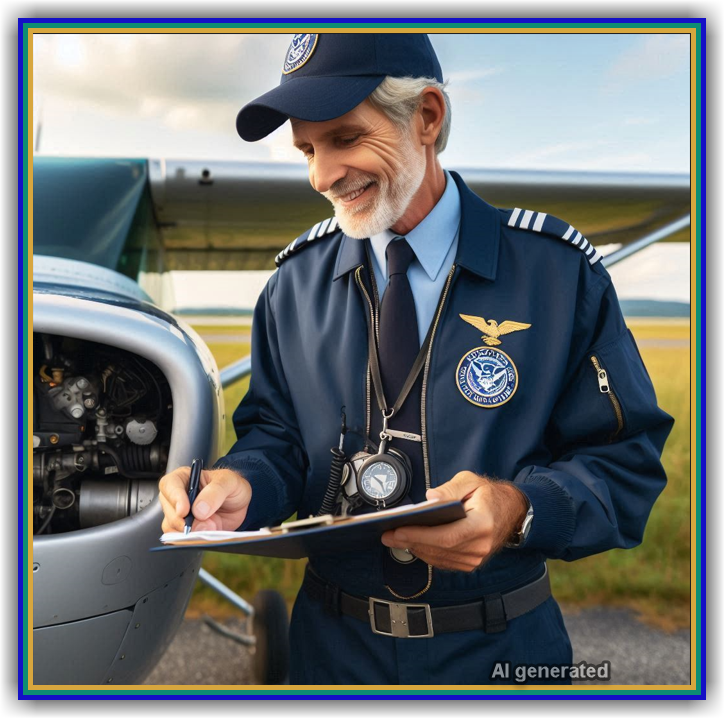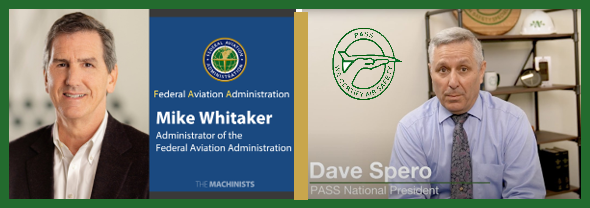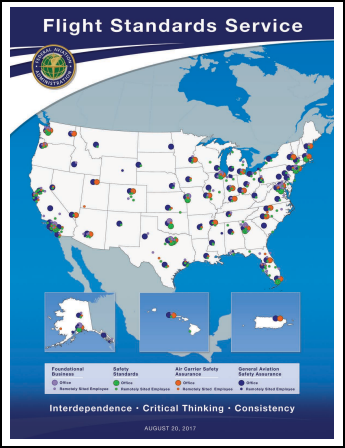New Flight Standards and Aircraft Certification- 2 day in office Contract- equivalent LEVEL OF SAFETY???

Not in the FAA press release (immediately below), a new contract with the 11,000 safety critical workers now have the contractual OPTION TO APPEAR AT THEIR OFFICES ONLY TWO DAYS A WEEK (from second section of this post)!!!
The Biden Administration, year ago, stated that it opposed such loose management approach to federal service:
“White House Chief of Staff Jeff Zients said in an email to Cabinet officials Friday that increasing the amount of in-person work is “CRITICAL” TO FEDERAL AGENCIES’ WORKPLACE CULTURE AND TO MEETING MISSIONS, although agencies will continue to make use of telework and authorize some workers to work fully remotely…”
“These changes will allow us to harness the benefits of enhanced flexibilities that we experienced during the pandemic, while ensuring we have the IN-PERSON TIME we need to build a strong culture, trust and interpersonal connections,” Zients wrote. “Newer members of our team—who will be the future leaders of our agencies—will have the face-to-face interaction critical to learning and growing, and all of us will benefit from the increases in morale, teamwork and productivity that come from in-person work.”
The value of “in person” work by the people being regulated by these FAA safety critical workers was established in a Chief Counsel Office opinion[1]. AIN’s headlines summarizes this legal opinion-“FAA Interpretation Disallows Remote Mx Supervision Letter further claims that non-licensed techs must be watched 100% of the time.” The letter as quoted by AIN:
“The Office of the Chief Counsel finds that the phrase ‘in person’ explicitly requires physical presence. Virtual presence, through a live video feed or other technological means, cannot replace the physical presence of a supervising mechanic. The term ‘in person’ is typically used to distinguish physical presence from mere virtual or remote presence, e.g. ‘Are we meeting in person today?’ Interpreting 43.3(d) to allow supervision by Zoom or FaceTime would render the phrase ‘in person’ redundant, but all parts of binding legal text must be given effect.”
Citing previous rulings, the FAA letter concluded: “In other words, mechanics must be able to physically intervene at every step of the process.” Thus, “A live video feed does NOT ALLOW FOR THIS LEVEL OF SUPERVISION. A remote supervisor cannot take over maintenance and can only see what the camera is pointed at. Anything out of frame will go unnoticed by even the most experienced mechanic.
“In the best-case scenario, a remotely supervising mechanic would be available for questions at any time and could remotely observe most steps of the work, but crucial details might remain out of frame and the supervisor would have no power to step in if necessary. That best-case scenario still would not be enough under 43.3(d).”
The third portion is a series of the FAA AVS website, and that verbatim text describes the mission and work of its more than 1400 engineers, scientists, inspectors, test pilots and other experts responsible for oversight of design, production, airworthiness certification, and continued airworthiness programs for all U.S. civil aviation products and foreign import products.” While their physical and mental assignments are substantially different from the supervision of maintenance personnel, the safety impact is dramatically HIGHER. These civil servants daily tasks impact, for example:
- Global and US standards in every aspect of aviation—such as
- Coordination on very delicate issues with internal FAA offices (e.g. the lawyers), the DOT, State, Commerce and the White House require observations of these players’ reactions to language, Administration positions, international implications, complex Cost/Benefit tests, environmental concerns, etc.
- The safety of the NAS—for example
- Inspection of an airline for example is not just a checklist, but a gestalt of factors—even a seasoned inspector may need to consult with a co-worker who is “distant” at such a crucial moment.
- SMS is the FAA’s primary safety tool. Its reliance on complex data frequently calls for sophisticated quantitative analysis. If the numbers expert is not at the office, reaching that person on a timely basis may not be readily available.
- AFS is charged with the oversight of the Air Traffic Control System. By definition this requires inter-divisional coordination and may mandate a real time correction. Facial expressions (the camera may not be on everyone) help resolve a potential conflict of significant implications.
- Coordination of an organization that spans multiple time zones is already testy. Adding the variable, that the actual inspectors may/may not be able to connect to a new initiative, may delay implementation of the FAA’s safety mission.
- There is no higher visibility FAA job than AIRCRAFT CERTIFICATION and the airworthiness review of designs is usually highly interconnected. Two days in the office, at best, minimizes this coordination. Not a good result from this policy which is contrary to the White House.
- Paperwork is a major product of AVS- drafting NPRMs, summarizing docket comments, writing/rewriting rules, word-smithing ACs/ADs/ ALERTs/SAFOs/SDRs/SAIBs/Handbooks, etc. involve working with others on your team. Being able to observe the others working on the same project provides excellent guidance of what is the collective pace. Staffers are assigned multiple tasks and must manage the time for each. Knowing that your desk mates are moving forward provides the in person cue that one of your collaborative portion should be equal in status.
The work of the AVS team is of such critical importance, certainly greater than an AMT, that in virtual presence cannot provide the same high standard of safety as in person. White House Chief of Staff Jeff Zients’ declaration that
- workplace culture,
- safety mission,
- trust,
- interpersonal conditions,
- morale,
- teamwork
- and
- productivity that come from in-person work
should prevail.


FAA and PASS sign collective bargaining agreement

The Federal Aviation Administration (FAA) and Professional Aviation Safety Specialists, AFL-CIO (PASS) have signed an agreement on a new contract for bargaining unit employees within the FLIGHT STANDARDS and AIRCRAFT CERTIFICATION organizations.
“The PASS workforce is an ESSENTIAL PART of the FAA’s effort to keeping the flying public safe and holding airplane manufacturers to the HIGHEST STANDARDS,” FAA Administrator MIKE WHITAKER said. “This agreement represents both parties’ shared commitment to safety and recognizes the hard work and dedication of our workforce.“
“I’m proud of the work our team did at the bargaining table,” PASS National President DAVE SPERO said. “It was challenging at times but in the end, we achieved a strong collective bargaining agreement that stressed recruitment and retention, as well as fair work rules, for employees who are critical to carrying out the FAA’s mission. I want to thank our members for their support and patience during the process.”

More details from AIN article:
FAA And PASS Forge New Contract
A new contract agreement between the FAA and PASS was announced Sept. 26.
Updated Sep 26, 2024 4:58 PM EDT
Excerpted

PASS represents approximately 11,000 FAA employees dedicated to flight safety and aircraft certification.
Under terms of the agreement, unionized employees in the FAA’s Flight Standards and Aircraft Certification organizations will receive a $5,000 cash bonus and will maintain THE OPTION TO WORK IN THE OFFICE JUST TWO DAYS A WEEK.


Facts about the SAFETY MISSION of these union members:
“Aviation Safety is an organization responsible for the certification, production approval, and continued airworthiness of aircraft; and certification of pilots, mechanics, and others in safety-related positions.
Aviation Safety is also responsible for:
- Certification of all operational and maintenance enterprises in domestic civil aviation”
· “Aircraft Certification Service (AIR)
- The Federal Aviation Administration’s (FAA) Aircraft Certification Service (AIR) is part of the Office of Aviation Safety (AVS) and includes more than 1400 engineers, scientists, inspectors, test pilots and other experts responsible for oversight of design, production, airworthiness certification, and continued airworthiness programs for all U.S. civil aviation products and foreign import products.”
- “Certification and safety oversight of approximately 7,300 U.S. commercial airlines and air operators”
- “Flight Standards Service
- The Flight Standards Service promotes safe air transportation by setting the standards for certification and oversight of airmen, air operators, air agencies, and designees. We also promote safety of flight of civil aircraft and air commerce by:
- Accomplishing certification, inspection, surveillance, investigation, and enforcement
- Setting regulations and standards
- Managing the system for registration of civil aircraft and certification of airmen
- The Service reorganized from a regionally (geographically) based organization to a functionally based organization and employs the Safety Management System (SMS) principles of safety assurance, safety standards, Safety Risk Management (SRM), and safety promotion.

- Civil flight operations
- Developing regulations”
An FAA Flight Safety Inspector, also known as an Aviation Safety Inspector (ASI), plays a crucial role in ensuring the safety and compliance of all aspects related to aviation. Here are some key responsibilities:
- Inspections: Conducting thorough inspections of aircraft, maintenance facilities, and repair stations to ensure they meet safety standards[2].
- Regulation Enforcement: Enforcing adherence to aviation safety regulations and standards[3].
- Investigations: Investigating accidents, incidents, and safety violations to determine causes and recommend corrective actions[4].
- Evaluations: Evaluating the performance of aircraft, avionics, and electrical systems, as well as the qualifications of pilots and mechanics[5].
- Documentation: Reviewing and maintaining detailed records of inspections, investigations, and compliance activities[6].
FAA Safety Inspectors work in four specialty areas: avionics, manufacturing, maintenance, and operations1. They ensure that all aircraft flying today are safe and compliant with federal regulations.
[1] Not clear that AGC-1 signed the opinion.
[3] zippia.com
[4] interviewguy.com
[5] Faasafety.gov
[6] faa.gov
